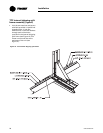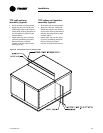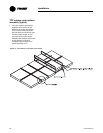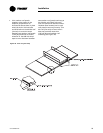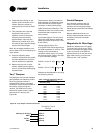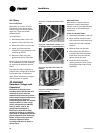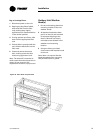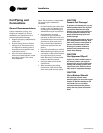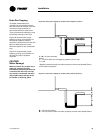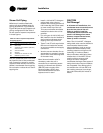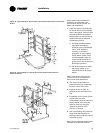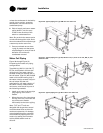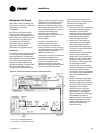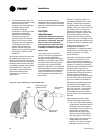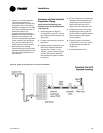
Installation
28 CAH-SVX01A-EN
Coil Piping and
Connections
General Recommendations
Proper installation, piping, and
trapping is necessary to ensure
satisfactory coil operation and to
prevent operational damage:
• Support all piping independently
of the coils.
• Provide swing joints or flexible
fittings on all connections that
are adjacent to heating coils to
absorb thermal expansion and
contraction strains.
• If the coil was ordered with
factory-mounted controls, install
the control valves. The valves
ship separately.
Note: The contractor is responsible
for supplying the installation
hardware.
• For best results, use a short pipe
nipple on the coil headers prior
to making any welded flange or
welded elbow type connections.
• Extended drain and vent
connections are provided as
standard on DD and D coils only.
If extended drains and vents are
required on other water coils,
they must be field-installed or
ordered as specials from the
factory.
• Pipe coils counterflow to airflow.
• When attaching the piping to the
coil header, make the connection
only tight enough to prevent
leaks. Maximum recommended
torque is 200 foot-pounds.
• Use pipe sealer on all thread
connections.
• After completing the piping
connections, seal around pipe
from inner panel to outer panel.
CAUTION
Prevent Coil Damage!
To prevent coil damage, do not use
teflon-based products for any field
connections because their high
lubricity may allow connections to
be over-tightened. Failure to use
proper materials may cause coil
header damage.
Seal the piping penetration into the
unit casing before insulating. Seal
from inner panel to outer panel to
prevent unconditioned air from
entering the module. Failure to
properly seal penetrations may
cause water leakage.
CAUTION
Use Approved Glycol!
If glycol is used in chilled water or
hot water systems, use a glycol
approved for use with commercial
cooling and heating systems and
copper tube coils. Failure to do so
may result in equipment damage.
CAUTION
Use a Backup Wrench!
Use a backup wrench when
attaching piping to coils with copper
headers to prevent damage to the
coil header. Do not use brass
connectors because they distort
easily and may cause connection
leaks.



